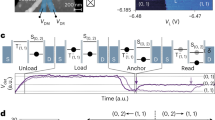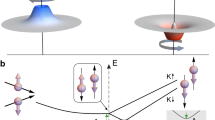Abstract
Exploiting the optical excitation selection rules in graphene quantum dots, we investigate theoretically the entanglement generation process and entanglement concentration process of valley qubits. Our protocol shows that the graphene-based quantum dots can be distributed in a maximally entangled state through the interaction with single photons. In our proposed scheme, the setups are simplified as only single-photon detection is required. This provides a fast, all-optical manipulation of on-chip qubits, which gives an effective way for quantum information processing in graphene-based solid qubits.
摘要
基于石墨烯量子点系统中光激发选择规则, 我们提出了一个纠缠产生和浓缩的理论方案。利用量子点系统与单光子的相互作用, 方案可以在石墨烯量子点系统中实现最大纠缠态的纠缠分发。方案的实现装置依赖于单光子探测过程, 简化了纠缠分发过程。该方案提供了基于片上量子比特的快速、全光操控方法, 可以被应用到石墨烯量子比特信息处理的方案中。




Similar content being viewed by others
References
DiVincenzo DP (2000) The physical implementation of quantum computation. Fortschr Phys 48:771–783
Wineland D, Blatt R (2008) Entangled states of trapped atomic ions. Nature 453:1008–1014
Man ZX, Su F, Xia YJ (2013) Stationary entanglement of two atoms in a common reservoir. Chin Sci Bull 58:2423–2429
Ma J, Li Y, Wu J et al (2014) Laser intensity induced transparency in atom-molecular transition process. Chin Sci Bull 59:2731–2735
Nakamura Y, Pashkin YA, Tsai JS (1999) Coherent control of macroscopic quantum states in a single-Cooper-pair box. Nature 398:786–788
Hanson R, Kouwenhoven LP, Petta JR et al (2007) Spins in few-electron quantum dots. Rev Mod Phys 79:1217–1265
Gaebel T, Domhan M, Popa I et al (2006) Room-temperature coherent coupling of single spins in diamond. Nat Phys 2:408–413
Castro NAH, Guinea F, Peres NMR et al (2009) The electronic properties of graphene. Rev Mod Phys 81:109–162
Rycerz A, Tworzydlo J, Beenakker CW (2007) Valley filter and valley valve in graphene. Nat Phys 3:172–175
Rohling N, Burkard G (2012) Universal quantum computing with spin and valley. New J Phys 14:083008
Wu GY, Lue NY, Chang L (2011) Graphene quantum dots for valley-based quantum computing: a feasibility study. Phys Rev B 84:195463
Wu GY, Lue NY (2012) Graphene-based qubits in quantum communications. Phys Rev B 86:045456
Julsgaard B, Sherson J, Cirac JI et al (2004) Experimental demonstration of quantum memory for light. Nature 432:482–486
Duan LM, Lukin MD, Cirac JI et al (2001) Long-distance quantum communication with atomic ensembles and linear optics. Nature 414:413–418
Cao DY, Liu BH, Wang Z et al (2015) Multiuser-to-multiuser entanglement distribution based on 1550 nm polarization-entangled photons. Sci Bull 60:1128–1132
Bennett CH, Bernstein HJ, Popescu S et al (1996) Concentrating partial entanglement by local operations. Phys Rev A 53:2046–2052
Yamamoto T, Koashi M, Imoto N (2001) Concentration and purification scheme for two partially entangled photon pairs. Phys Rev A 64:012304
Zhao Z, Yang T, Chen YA et al (2003) Experimental realization of entanglement concentration and a quantum repeater. Phys Rev Lett 90:207901
Yamamoto T, Koashi M, Ozdemir SK et al (2003) Experimental extraction of an entangled photon pair from two identically decohered pairs. Nature 421:343–346
Sheng YB, Deng FG, Zhou HY (2008) Nonlocal entanglement concentration scheme for partially entangled multipartite systems with nonlinear optics. Phys Rev A 77:062325
Sheng YB, Zhou L, Zhao SM et al (2012) Efficient single-photon-assisted entanglement concentration for partially entangled photon pairs. Phys Rev A 85:012307
Deng FG (2012) Optimal nonlocal multipartite entanglement concentration based on projection measurements. Phys Rev A 85:022311
Sheng YB, Pan J, Guo R et al (2015) Efficient N-particle W state concentration with different parity check gates. Sci China Phys Mech Astron 58:060301
Du FF, Deng FG (2015) Heralded entanglement concentration for photon systems with linear-optical elements. Sci China Phys Mech Astron 58:040303
Sheng YB, Liu J, Zhao SM et al (2013) Multipartite entanglement concentration for nitrogen-vacancy center and microtoroidal resonator system. Chin Sci Bull 58:3507–3513
Wang HF, Sun LL, Zhang S et al (2012) Scheme for entanglement concentration of unknown partially entangled three-atom W states in cavity QED. Quantum Inf Process 11:431–441
Zhang R, Zhou SH, Cao C (2014) Efficient nonlocal two-step entanglement concentration protocol for three-level atoms in an arbitrary less-entangled W state using cavity input-output process. Sci China Phys Mech Astron 57:1511–1518
Maimaiti W, Li Z, Chesi S et al (2015) Entanglement concentration with strong projective measurement in an optomechanical system. Sci China Phys Mech Astron 58:050309
Emary C, Trauzettel B, Beenakker CWJ (2005) Emission of polarization-entangled microwave photons from a pair of quantum dots. Phys Rev Lett 95:127401
Budich J, Trauzettel B (2010) Entanglement transfer from electrons to photons in quantum dots: an open quantum system approach. Nanotechnology 21:274001
Fischer J, Trauzettel B, Loss D (2009) Hyperfine interaction and electron-spin decoherence in graphene and carbon nanotube quantum dots. Phys Rev B 80:155401
Lansbergen GP, Rahman R, Verduijn J et al (2011) Lifetime-enhanced transport in silicon due to spin and valley blockade. Phys Rev Lett 107:136602
Deng GW, Wei D, Li SX et al (2014) Coupling two distant double quantum dots to a microwave resonator. arXiv:1409.4980
Wei HR, Deng FG (2013) Universal quantum gates for hybrid systems assisted by quantum dots inside double-sided optical microcavities. Phys Rev A 87:022305
Sarandy MS, Lidar DA (2005) Adiabatic quantum computation in open systems. Phys Rev Lett 95:250503
Feng GR, Xu GF, Long GL (2013) Experimental realization of nonadiabatic Holonomic quantum computation. Phys Rev Lett 110:190501
Cao Y, Li H, Long GL (2013) Entanglement of linear cluster states in terms of averaged entropies. Chin Sci Bull 58:48–52
Guo Y, Hou JC (2013) Entanglement detection beyond the CCNR criterion for infinite-dimensions. Chin Sci Bull 58:1250–1255
Su XL (2014) Applying Gaussian quantum discord to quantum key distribution. Chin Sci Bull 59:1083–1090
Wang C (2012) Efficient entanglement concentration for partially entangled electrons using a quantum-dot and microcavity coupled system. Phys Rev A 86:012323
Sheng YB, Zhou L, Wang L et al (2013) Efficient entanglement concentration for quantum dot and optical microcavities systems. Quantum Inf Process 12:1885–1895
Lidar DA, Chuang IL, Whaley KB (1998) Decoherence-free subspaces for quantum computation. Phys Rev Lett 81:2594–2597
Acknowledgments
This work was supported by the National Natural Science Foundation of China (11404031, 61205117, and 61471050), Beijing Higher Education Young Elite Teacher Project (YETP0456), the Fundamental Research Funds for the Central Universities (2014RC0903), and the State Key Laboratory of Information Photonics and Optical Communications (Beijing University of Posts and Telecommunications).
Author information
Authors and Affiliations
Corresponding author
Ethics declarations
Conflict of interest
The authors declare that they have no conflict of interest.
About this article
Cite this article
Wang, C., Shen, WW., Mi, SC. et al. Concentration and distribution of entanglement based on valley qubits system in graphene. Sci. Bull. 60, 2016–2021 (2015). https://doi.org/10.1007/s11434-015-0941-6
Received:
Accepted:
Published:
Issue Date:
DOI: https://doi.org/10.1007/s11434-015-0941-6




